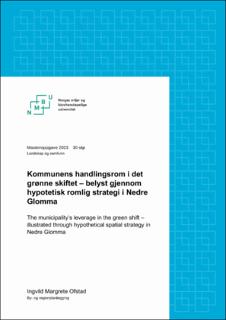| dc.contributor.advisor | Marius Grønning | |
| dc.contributor.author | Ofstad, Ingvild Margrete | |
| dc.date.accessioned | 2024-02-15T17:27:17Z | |
| dc.date.available | 2024-02-15T17:27:17Z | |
| dc.date.issued | 2023 | |
| dc.identifier | no.nmbu:wiseflow:6985758:56818918 | |
| dc.identifier.uri | https://hdl.handle.net/11250/3118050 | |
| dc.description.abstract | Kommunen, i sin rolle som planmyndighet, skal ikke bare fastsette mål for bærekraftig utvikling. Den skal og presentere hvordan en utviklingsretning kan nå målene. Mens retningslinjer fra staten skal hensyntas, bør kommunen også utforske muligheter som kan ligge bak dagsordenen. Jeg undersøker om Fredrikstad kommune har et slikt handlingsrom.
Ofte blir bærekraftig utvikling av byer koblet til konsepter som kompakte byer, knutepunktutvikling og fortetting rundt jernbanestasjoner, og konsentrasjon av vekst innenfor byens sentrum. Byer som en gang var industrielle, kan dra nytte av store nedlagte industriområder i sentrum som kan transformeres til nye formål. Imidlertid, dersom byen har industriområder utenfor sentrum, kan fokus på knutepunkter i bykjernen være mindre relevant for byens totale og langsiktige utvikling. Dette adresseres i Fredrikstad, spesielt med den noe oversette ‘Plankebyen’. I sin tid var det i alt 32 sagbruk og 18 teglverk, flesteparten utenfor dagens byområde. Noen av disse er nedbrent eller fragmentert, mens andre fortsatt er i bruk til nye virksomheter.
Studien utfører analyser med utgangspunkt i industriområders arealreserve og industriarv. Målet er å utforske hvordan materialer arvet fra industrien kan gjenbrukes, og dermed påvirke hvordan framtidens byform kan løses. Dette gjøres gjennom tre ulike romlige objekter, i tre forskjellige romlige skalaer. Nedre Glomma i en lineær byform blir observert, blir undersøkt og fremhevet som en måte å utnytte handlingsrommet. Begrepet ‘materiale’ er sentralt for denne tilnærmingen. En utvidet forståelse av materiale, som omfatter et romlig objekt bestående av sammensatte strukturer, viser seg å være fruktbar for å operasjonalisere en kretsløpstankegang i byplanlegging. Denne tilnærmingen bidrar også til å nyansere hvordan vernementalitet ikke nødvendigvis sammenfaller med de materialene arvet fra industrien. Basert på dette utformer jeg en hypotetisk bystruktur og hvordan den kan gjenbruke industriens arv og materiale i sin helhet. Det har et omstillingspotensial med en lokalt tilpasset utviklingsretning, samt nyanserer det hvordan enkelte fysiske kulturminner kan ses som helhetlig arv. | |
| dc.description.abstract | The municipality, in its role as the planning authority, is not only tasked with establishing goals for sustainable development but also with presenting how a chosen developmental direction can achieve these objectives. While state guidelines should be considered, the municipality should also explore opportunities that may go beyond the current agenda. I am investigating whether the municipality of Fredrikstad has such a leverage.
Sustainable urban development is often associated with concepts such as compact cities, hub development, and densification around railway stations, with a concentration of growth within the city center. Cities that were once industrial can benefit from extensive abandoned industrial areas in the city center that can be transformed for new purposes. However, if the city has industrial areas outside the center, the focus on hubs in the city core may be less relevant for the overall and long-term development of the city. This is addressed in Fredrikstad, particularly with the somewhat overlooked ‘Plankebyen’. In its time, there were a total of 32 sawmills and 18 brickworks, mostly outside the current urban area. Some of these have burned down or fragmented, while others are still in use for new businesses.
The study conducts analyses based on industrial areas' spatial reserves and industrial heritage. The goal is to explore how materials inherited from industry can be reused, thereby influencing how the future urban form can be shaped. This is achieved through three different spatial objects, at three different spatial scales. Nedre Glomma in a linear urban form is observed, examined, and highlighted as a way to utilize the leeway. The concept of 'material' is crucial to this approach. An expanded understanding of material, encompassing a spatial object consisting of composite structures, proves fruitful for operationalizing a circular thinking approach in urban planning. This approach also contributes to nuanced perspectives on how preservation mentality does not necessarily coincide with the materials inherited from industry. Based on this, I formulate a hypothetical urban structure and how it can reuse the industry's heritage and materials as a whole. It has transformative potential with a locally tailored development direction, while also refining how certain physical cultural heritage sites can be viewed in a more comprehensive way as legacies. | |
| dc.language | nob | |
| dc.publisher | Norwegian University of Life Sciences | |
| dc.title | Kommunens handlingsrom i det grønne skiftet - belyst gjennom hypotetisk romlig strategi for Nedre Glomma | |
| dc.type | Master thesis | |
